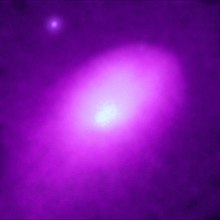Abell 2142
Abell 2142 ( A2142 for short ) is a huge, X- ray bright galaxy cluster in the constellation Corona Borealis . It is the result of a currently ongoing merger of two galaxy clusters. The galaxy cluster extends for more than 6 million light years and contains several hundred galaxies . Abell 2142 has a heliocentric redshift of approximately 0.090. This corresponds to a radial speed of around 27,000 km / s, which results in a distance of over 1.2 billion light years (370 M pc ). The cluster is dominated by two huge cD galaxies and is therefore classified as type B ( binary ) in the classification scheme of Rood and Sastry . The radial velocities of the two central galaxies differ by the very large amount of 1650 km / s, which is interpreted as a further indication that a merging process of galaxy clusters is actually taking place. The name Abell 2142 goes back to the entry in the Abell catalog , a catalog of galaxy clusters.
X-ray image
The picture above right was taken on August 20, 1999 by Chandras with the 0.3–10.0 k eV Advanced CCD Imaging Spectrometer (ACIS). It shows an area of 7.5 × 7.2 arc minutes . The collision of the two large galaxy clusters can then be seen. The bright central region is cooler with approx. 50 million Kelvin than the surrounding, elongated clouds with a temperature of 70 million Kelvin. All of this moves in a thin "atmosphere" of 100 million Kelvin hot gas. The bright point in the upper left is an active galaxy within the cluster.
Dynamics of merging the piles
Abell 2142 has attracted some attention as it opens up the possibility of studying the merging of galaxies in more detail. Galaxy clusters grow by the attraction of smaller groups and clusters. During the merger, the kinetic energy of the colliding objects heats the gas between the colliding clusters, resulting in a marked difference in gas temperature. These differences contain information about the stage, geometry and speed of the merge. An accurate temperature map can provide various information about the nature of the underlying physical processes. Earlier studies (for example by ROSAT or ASCA ) did not have the capabilities of Chandra and XMM-Newton and could not map the region in detail.
Chandra has succeeded in measuring fluctuations in temperature, density and pressure with high resolution. "Now we can begin to understand the physics of such merging processes, which are among the most energetic events in the universe," said Maxim Markevitch of the Harvard-Smithsonian Center for Astrophysics, head of the international team involved in analyzing the observations. "The pressure and density maps of the cluster show a sharp boundary that can only exist in the moving environment of a merger."
The X-ray emissions observed in Abell 2142 are largely smooth and symmetrical, suggesting that the object is the result of the merging of two galaxy clusters that we observe in the stage at least 1-2 billion years after the first encounter. One would expect to see non-uniform x-ray emissions and clear collision fronts if there were an earlier stage of fusion. Markevitch et al. suggested that the central galaxy (called G1) of the more massive cluster merged with the former central galaxy (G2) of the less massive cluster. The relatively cool central area suggests that the heating of the central core was not caused by the heating from shock fronts in earlier stages of the merger, and that this instead interacts with the surrounding gas.
See also
Individual evidence
- ↑ a b c Cosmic Pressure Fronts Mapped by Chandra . In: CXC PR: 00-08 . Harvard-Smithsonian Center for Astrophysics . March 1, 2000. Retrieved October 2, 2011.
- ↑ NASA / IPAC Extragalactic Database . In: Results for Abell 2142 . Retrieved November 11, 2008.
- ^ Henry, J. Patrick; Briel, Ulrich G .: An X-Ray Temperature Map of Abell 2142 . In: Astrophysical Journal . No. 472 , 1996, pp. 137 ff ., doi : 10.1086 / 178049 .
- ↑ a b Markevitch, M., et al .: Chandra Observations of Abell 2142: Survival of Dense Subcluster Cores in a Merger . In: Astrophysical Journal . Vol. 541, No. 2 , October 2000, p. 542-549 , doi : 10.1086 / 309470 , arxiv : astro-ph / 0001269 , bibcode : 2000ApJ ... 541..542M .
